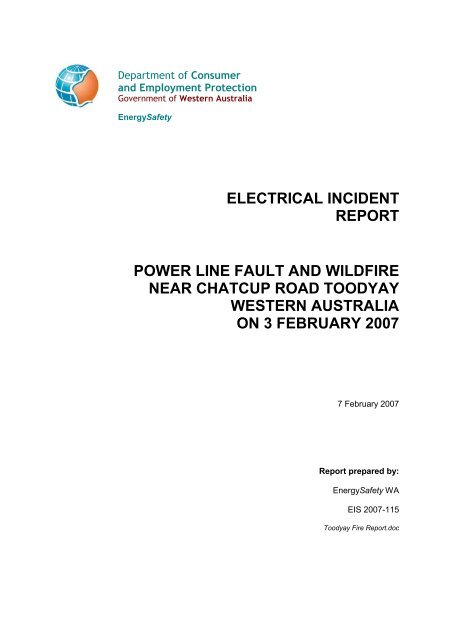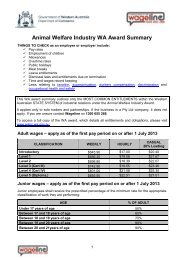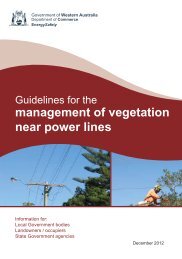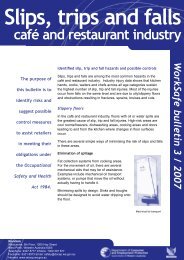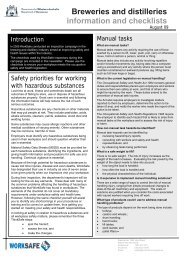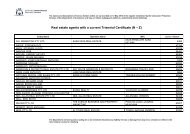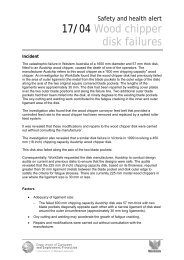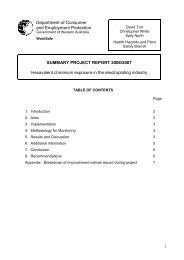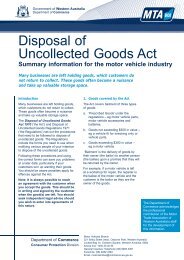electrical incident report power line fault and wildfire near chatcup ...
electrical incident report power line fault and wildfire near chatcup ...
electrical incident report power line fault and wildfire near chatcup ...
You also want an ePaper? Increase the reach of your titles
YUMPU automatically turns print PDFs into web optimized ePapers that Google loves.
�����������������������<br />
��������������������������<br />
��������������������������������<br />
�<br />
EnergySafety<br />
ELECTRICAL INCIDENT<br />
REPORT<br />
POWER LINE FAULT AND WILDFIRE<br />
NEAR CHATCUP ROAD TOODYAY<br />
WESTERN AUSTRALIA<br />
ON 3 FEBRUARY 2007<br />
7 February 2007<br />
Report prepared by:<br />
EnergySafety WA<br />
EIS 2007-115<br />
Toodyay Fire Report.doc
TABLE OF CONTENTS<br />
1 INTRODUCTION ........................................................................................................... 3<br />
1.1 Time <strong>and</strong> Date of Occurrence ................................................................................ 3<br />
1.2 Notification of Incident............................................................................................ 3<br />
1.3 Investigating Inspectors ......................................................................................... 3<br />
2 SUMMARY .................................................................................................................... 4<br />
3 ORIGIN OF THE WILDFIRE.......................................................................................... 5<br />
4 INVESTIGATION ANALYSIS......................................................................................... 6<br />
4.1 Examination of the 22 kV Overhead Power Line .................................................... 6<br />
4.2 Weather Conditions <strong>and</strong> Topography..................................................................... 7<br />
4.3 Other Sources of Ignition - Eliminated.................................................................... 7<br />
4.4 The Effect of a Short Circuit on an Overhead High Voltage Power Line ................. 7<br />
5 CONCLUSIONS ............................................................................................................ 8<br />
APPENDIX A: LOCATION MAP ............................................................................................ 9<br />
APPENDIX B: NETWORK DIAGRAM .................................................................................10<br />
APPENDIX C: PHOTOGRAPHS .........................................................................................11<br />
Photograph No 1: - Origin of <strong>wildfire</strong> .............................................................................11<br />
Photograph No 2: - Pole 98 � Broken earth conductor..................................................12<br />
Photograph No 3: - Contact marks <strong>and</strong> metal globules on the red phase conductor .....12<br />
Photograph No 4: - Pole 97 � Damaged by fire.............................................................13<br />
Photograph No 5: - Contact marks <strong>and</strong> metal globules on the broken earth conductor.13<br />
2
1 INTRODUCTION<br />
A <strong>wildfire</strong> occurred <strong>near</strong> Toodyay on 3 February 2007 <strong>and</strong> the Fire <strong>and</strong> Emergency Service<br />
Authority (FESA) advised EnergySafety on 4 February 2007 that the <strong>wildfire</strong> originated<br />
directly beneath a Western Power three phase 22 kV overhead <strong>power</strong> <strong>line</strong>. An investigation<br />
has been conducted <strong>and</strong> this <strong>report</strong> summarises EnergySafety�s findings.<br />
EnergySafety�s investigation has found that at approximately 1400 hours on 3 February 2007<br />
conductors clashed on a Western Power 22 kV overhead <strong>power</strong> <strong>line</strong> north of Toodyay<br />
approximately midway between poles number 97 <strong>and</strong> number 98. A short circuit <strong>fault</strong><br />
ensued, as evidenced from the burn marks <strong>and</strong> metal globules on the conductors, <strong>and</strong> there<br />
is a high probability that this resulted in molten metal falling to ground, igniting dry stubble<br />
under the <strong>power</strong> <strong>line</strong>.<br />
This investigation could not have been completed without the cooperation <strong>and</strong> assistance of<br />
FESA, Western Power <strong>and</strong> the WA Police Service.<br />
1.1 Time <strong>and</strong> Date of Occurrence<br />
Approximately 1400 hours on Saturday 3 February 2007.<br />
1.2 Notification of Incident<br />
EnergySafety was notified of the <strong>incident</strong> by Mr Brynn Weir an investigation officer of the<br />
Western Australian Fire <strong>and</strong> Emergency Service Authority (FESA) at 1025 hours on 4<br />
February 2007 (FESA <strong>incident</strong> number 2006068250). Mr Michael Bunko, EnergySafety�s<br />
Chief Electrical Inspector advised the Director of Energy Safety, Mr Albert Koenig. He also<br />
arranged for an investigation to commence in liaison with FESA <strong>and</strong> Western Power later<br />
that day at Toodyay.<br />
1.3 Investigating Inspectors<br />
The following EnergySafety WA personnel carried out the onsite investigation:<br />
�� Mr Todd Bell, Senior Electrical Inspector; <strong>and</strong><br />
�� Mr Norman McKendry, Senior Electrical Engineer.<br />
Mr Bell initially inspected the <strong>wildfire</strong> scene on 4 February 2007 <strong>and</strong> both Mr Bell <strong>and</strong><br />
Mr McKendry visited the site again on 5 February 2007.<br />
3
2 SUMMARY<br />
In consideration of prevailing weather conditions around 1400 hours on 3 February 2007 <strong>and</strong><br />
all the technical evidence available, a short circuit <strong>fault</strong> resulted from conductors clashing on<br />
a Western Power 22kV overhead <strong>power</strong> <strong>line</strong> north of Toodyay. The <strong>power</strong> <strong>line</strong> is the<br />
Northam to Bolgart 22kV Feeder <strong>and</strong> the <strong>fault</strong> occurred midspan between poles number 97<br />
<strong>and</strong> number 98.<br />
The span length between poles number 97 <strong>and</strong> number 98 is 182 metres. The crossarms<br />
used for this span are longer than st<strong>and</strong>ard <strong>and</strong> this configuration is commonly referred to by<br />
Western Power as an anti-swan (i.e. large bird) construction. This longer crossarm is utilised<br />
to provide greater separation between the phase conductors <strong>and</strong> the underslung earth<br />
conductor.<br />
Notwithst<strong>and</strong>ing the use of this type of construction, it is concluded that the red phase<br />
conductor <strong>and</strong> the underslung earth conductor made direct contact with each other in the<br />
strong gusting wind <strong>and</strong> high ambient air temperature.<br />
The evidence indicates the ensuing short circuit <strong>fault</strong> resulted in hot metal particles igniting<br />
dry stubble under the <strong>power</strong> <strong>line</strong>.<br />
The clashing of conductors as described above raises the question of a deficiency, since<br />
conductor separation should have been sufficient to avoid such a <strong>fault</strong>. However, the type of<br />
construction used on this <strong>power</strong> <strong>line</strong> has traditionally performed satisfactorily within the<br />
Western Power network (<strong>and</strong> is different to that of <strong>power</strong> <strong>line</strong>s where previous clashing has<br />
occurred, resulting in serious <strong>wildfire</strong>s).<br />
It is clear that significant further engineering investigation will be required by Western Power,<br />
in conjunction with EnergySafety, to deal with the above question <strong>and</strong> to assess whether this<br />
was an isolated problem, or whether it is an indication of a more systemic problem, <strong>and</strong> the<br />
type <strong>and</strong> extent of corrective action required.<br />
4
3 ORIGIN OF THE WILDFIRE<br />
The FESA investigator estimated that the <strong>wildfire</strong>��������������������������������������������<br />
paddock southwest of the Bindi Bindi -Toodyay Road between Church Gully <strong>and</strong> Chatcup<br />
Roads approximately 12 kilometres North of Toodyay.<br />
An inspection of the ignition point indicated that a large area of grass paddock had burnt out<br />
adjacent to the Western Power 22 kV overhead <strong>power</strong> <strong>line</strong>. The <strong>wildfire</strong> had continued in a<br />
South Easterly direction, which is consistent with the <strong>wildfire</strong> being driven forward from the<br />
point of ignition by wind coming from the North West.<br />
The <strong>power</strong> <strong>line</strong> (Northam 535.0 Feeder) originates at Western Power����������������������<br />
<strong>and</strong> extends via Toodyay to Bolgart.<br />
5
4 INVESTIGATION ANALYSIS<br />
4.1 Examination of the 22 kV Overhead Power Line<br />
The Western Power Northam to Bolgart (535.0) overhead 22 kV feeder specifications are:<br />
�� Phase conductors (x3): Steel cored aluminium<br />
�� Underslung earth conductor: Galvanised steel wire (rusted)<br />
�� Pole material: Wood<br />
�� Pole lengths (#97 <strong>and</strong> #98): 11 metres<br />
�� Pole height above ground: 9.5 metres<br />
�� Span length (poles #97 to #98): 182 metres<br />
�� Crossarm material: Wood<br />
�� Crossarm length: 2.8 metres<br />
�� Direction of <strong>power</strong> <strong>line</strong>: North South orientation<br />
The span length between poles number 97 <strong>and</strong> number 98 is 182 metres. The crossarms<br />
used for this span are longer than st<strong>and</strong>ard <strong>and</strong> this configuration is commonly referred to by<br />
Western Power as an anti-swan (i.e. large bird) construction. This longer crossarm is utilised<br />
to provide greater separation between the phase conductors <strong>and</strong> the underslung earth<br />
conductor.<br />
Inspection of the <strong>power</strong> <strong>line</strong> found evidence of damage to the overhead <strong>power</strong> <strong>line</strong><br />
conductors between poles number 97 <strong>and</strong> number 98 on the Northam to Bolgart 22 kV<br />
Feeder (535.0). The damage consisted of electric arc burn marks on the outer steel cored<br />
aluminium conductor (red phase) <strong>and</strong> on the underslung earth conductor <strong>near</strong> <strong>and</strong> at the<br />
point where it was subsequently broken. This was immediately below the damage to the red<br />
phase conductor.<br />
Pole number 97 was damaged by the <strong>wildfire</strong> on the 3 February 2007, causing it to fall<br />
towards the ground. The damaged <strong>power</strong> <strong>line</strong> was still live when discovered <strong>and</strong> the<br />
conductors remained suspended above ground by the crossarm. There was no evidence of<br />
a pole top fire, the pole base was burnt from the fire further suggesting it did not contribute to<br />
the point of ignition.<br />
Western Power staff became aware of the damaged pole <strong>and</strong> replaced the pole on 4<br />
February 2007.<br />
Western Power also recorded an intermittent <strong>fault</strong> on the <strong>power</strong> <strong>line</strong> on 3 February 2007 at<br />
approximately 1400 hours. This <strong>fault</strong> coincides with the commencement of the <strong>wildfire</strong>.<br />
6
4.2 Weather Conditions <strong>and</strong> Topography<br />
The weather at Northam for 3 February 2007 was recorded as follows:<br />
NW wind at 44 kph<br />
Relative Humidity 8%<br />
Ambient air temperature was approximately 46��<br />
The sky was clear <strong>and</strong> there was no evidence of lightning in the area.<br />
The ground between poles number 97 <strong>and</strong> number 98 is formed in the shape of a valley.<br />
The ground, before the <strong>wildfire</strong> was covered with dry stubble from a crop.<br />
4.3 Other Sources of Ignition - Eliminated<br />
Consideration was given to various possibilities of other sources of ignition at the <strong>power</strong> <strong>line</strong>,<br />
such as an <strong>electrical</strong>ly caused pole-top fire, a high tensile physical failure of the steel earth<br />
wire which may have caused it to flick up into the phase conductor above, or wind-borne<br />
material (such as twigs) striking <strong>and</strong> snagging on the <strong>power</strong> <strong>line</strong>, however, all the evidence<br />
led to the conclusion that the source of ignition was the clashing of the conductors.<br />
For example, the earth conductor exhibited damage at the break point that is consistent with<br />
<strong>electrical</strong> arcing between it <strong>and</strong> another conductor<strong>and</strong> there was evidence of multiple burn<br />
marks on the phase conductor.<br />
4.4 TheEffectofaShortCircuitonanOverheadHighVoltagePowerLine<br />
When a live bare high voltage conductor <strong>and</strong> earth conductor come together they cause an<br />
arc to develop across the air gap between them or at the point of actual contact. In both<br />
cases a significant amount of electric energy passes between the two conductors <strong>and</strong> a large<br />
quantity of heat is produced in the metal at the point where the arc is formed. This heat<br />
causes melting of the metal resulting in welding of the conductors <strong>and</strong> the formation of<br />
molten metal globules that would disperse away from the arc <strong>and</strong> fall to the ground whilst still<br />
hot.<br />
7
5 CONCLUSIONS<br />
There are a number of inter-related events, circumstances <strong>and</strong> factors that coincided on the<br />
day of the <strong>wildfire</strong>. Taking all evidence into account the conclusion is reached that:<br />
�� There are no suspicious circumstances relating to the origin of the fire.<br />
�� The <strong>wildfire</strong> <strong>incident</strong> originated at midspan between poles number 97 <strong>and</strong> number 98 on<br />
the Northam to Bolgart 22kV overhead <strong>power</strong> <strong>line</strong> (Feeder 535.0), North of Toodyay <strong>and</strong><br />
South East of Bindi Bindi � Toodyay Road between Church Gully Road <strong>and</strong> Chatcup<br />
Roads.<br />
�� The <strong>wildfire</strong> resulted from the ignition of the dry stubble on the ground due to hot metal<br />
globules falling from a 22 kV conductor clashing with an underslung earth conductor on<br />
the Western Power Northam to Bolgart overhead <strong>power</strong> <strong>line</strong> (Feeder 535.0), between<br />
poles number 97 <strong>and</strong> number 98.<br />
�� The clashing of conductors as described above raises the question of a deficiency, since<br />
conductor separation should have been sufficient to avoid such a <strong>fault</strong>. However, the<br />
type of construction used on this <strong>power</strong> <strong>line</strong> has traditionally performed satisfactorily<br />
within the Western Power network (<strong>and</strong> is different to that of <strong>power</strong> <strong>line</strong>s where previous<br />
clashing has occurred, resulting in serious <strong>wildfire</strong>s).<br />
�� It is clear that significant further engineering investigation will be required by Western<br />
Power, in conjunction with EnergySafety, to deal with the above question <strong>and</strong> to assess<br />
whether this was an isolated problem, or whether it is an indication of a more systemic<br />
problem, <strong>and</strong> the type <strong>and</strong> extent of corrective action required.<br />
8
APPENDIX A: LOCATION MAP<br />
Origin of Wildfire<br />
9
APPENDIX B: NETWORK DIAGRAM<br />
Origin of Wildfire<br />
10
APPENDIX C: PHOTOGRAPHS<br />
���������������������������������������<br />
Photograph taken at Culham Farm, Toodyay on 3 February 2007 by Senior Electrical<br />
Inspector Todd Bell, EnergySafety.<br />
11
���������������������������������������������������<br />
Photograph taken at Culham Farm, Toodyay on 3 February 2007 by Senior Electrical<br />
Inspector Todd Bell, EnergySafety.<br />
�������������������������������������������������������������������������������<br />
Photograph taken at Culham Farm, Toodyay on 3 February 2007 by Senior Electrical<br />
Inspector Todd Bell, EnergySafety.<br />
12
����������������������������������������������<br />
Photograph taken at Culham Farm, Toodyay on 3 February 2007 by Senior Electrical<br />
Inspector Todd Bell, EnergySafety.<br />
����������������������������������������������������������������������������������<br />
Photograph taken at Culham Farm, Toodyay on 3 February 2007 by Senior Electrical<br />
Inspector Todd Bell, EnergySafety.<br />
13


